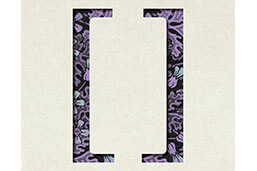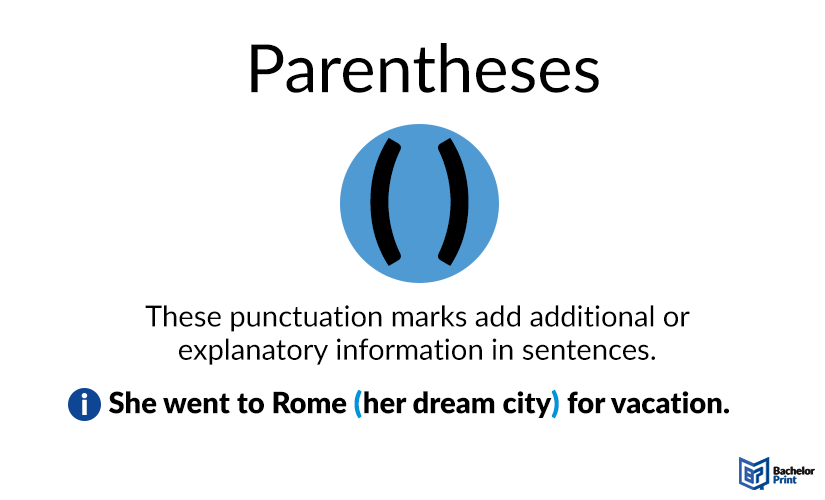
Although we use brackets (), also called round brackets, in daily in academic writing, most people do not know the language rules of using brackets correctly. They help provide additional information to a sentence without disrupting the main idea. This article will cover everything you need to know about brackets, when to use them and how to do so correctly.
Definition: Parentheses
Parentheses are curved punctuation marks used to enclose additional information in writing. Their primary purpose is to allow the writer an opportunity to add text or comments that may serve to clarify or illustrate what they’ve written. These punctuation marks also create room for digressions or afterthoughts in writing.

Placement of punctuation
The use of brackets in correlation with other punctuation in a sentence can be quite tricky. It is essential to know when to include the mark into the round brackets and when to leave it out.
- Periods (.) are generally placed outside the brackets, whether the insertion is a complete sentence or not. Only if the brackets enclose a complete sentence that follows the full stop of the last sentence, the full stop is placed inside the brackets.
- If the brackets are followed by a comma (,) that comma is always placed outside the round brackets.
- Question marks (?) and exclamation marks (!) can be inserted in brackets if necessary. However, if the sentence that includes them ends with the same punctuation mark, you need to remove the mark inside the round brackets.
How to use
Parentheses always include additional information. This is why the sentence must not lack anything if the brackets are removed. In some cases, like the second example, this can lead to an odd sounding sentence and should thus be avoided, even though it is grammatically correct.
When to use
Parenthesis can be of use in many different situations. When writing a text, it is important to only use them, if necessary, as to not complicate the text gratuitously. The following examples show you when it is required or logical to use brackets.
- Parentheses can be used to add nonessential information or additions that do not fit into the sentence normally.
- Use brackets to further describe preceding words if needed.
- They are also widely used for references in documents.
- The most common use for brackets is for abbreviations.
- Parentheses can also be useful in horizontal lists to keep track of the bullet points.
- Furthermore, brackets are used when numerals are put behind a spelt -out number or the other way round, for example in documents about money transfer.
Side-by-side brackets
Writers use side-by-side brackets when they need to place two or more parenthetical elements in a single sentence. The rules for using these punctuation marks vary from one academic style to the other.
| APA Style | Example |
| Use a single set of brackets and separate parenthetical elements with a colon. | The school visited the Wild Place Project (WPP; Bristol, 2015). |
| Chicago Style | Example |
| You can use a single set of brackets, but allows two sets of parens if the parenthetical phrase/elements are unrelated. | The school visited the Wild Place Project (WPP), (Bristol 2015) |
Nested brackets
Writers use nested brackets to enclose a set of parens inside another set. This can happen:
- When inserting additional information about an in-text citation
- When naming an organisation in brackets followed by its abbreviations
It is good practice to use square brackets for the inner element.
It is advisable to avoid using nested parens whenever possible since it can lead to confusion about where the elements start and stop. One of the best solutions is using square brackets for the inner element (as shown in the example above) to differentiate them from the original parens. You can also rephrase the sentences to eliminate one of the parenthetical elements.
Parentheses vs. brackets
Parentheses () are also called round brackets, while brackets [] are sometimes referred to as square brackets. Parentheses are used to place additional information in a sentence. Brackets, on the other hand, indicate elements in a quote that were not in the original version of it. They are mostly used to make a quote fit the grammar of a sentence, or to clarify meaning if necessary.
FAQs
Parentheses are used when you want to add nonessential information to a sentence, that helps to clarify a point. You put that text inside the round brackets not to disturb the reader, as brackets are easy to spot and can be skipped at first.
Yes, it is most often the case that a sentence with brackets ends with them. However, you need to watch out to put the full stop outside the round brackets for correct grammar.
If only the text inside brackets is a question, the question mark is put inside the round brackets. However, if the whole sentence is a question, even if the insertion adds to that, the only question mark is placed outside the brackets at the end of the sentence.
- ✓ 3D live preview of your individual configuration
- ✓ Free express delivery for every single purchase
- ✓ Top-notch bindings with customised embossing

